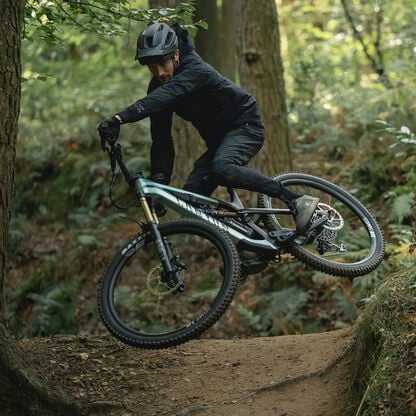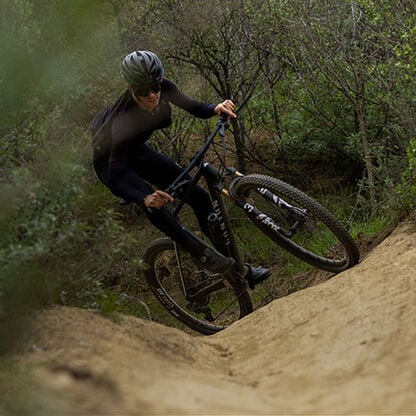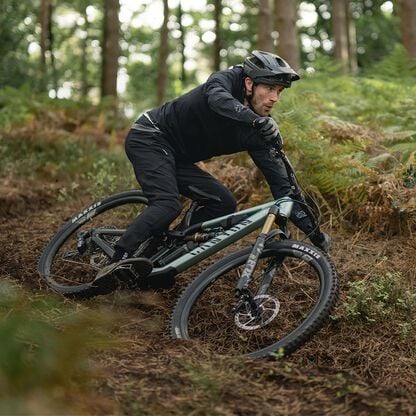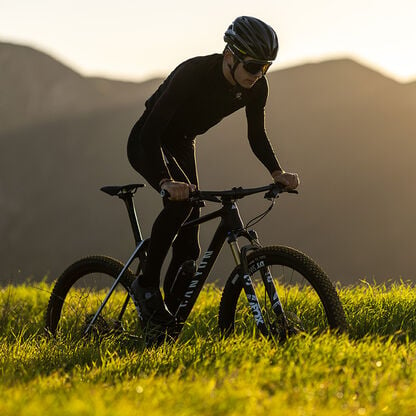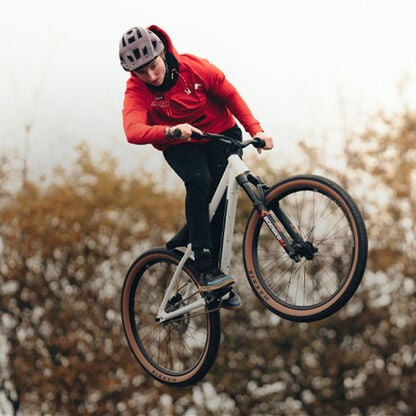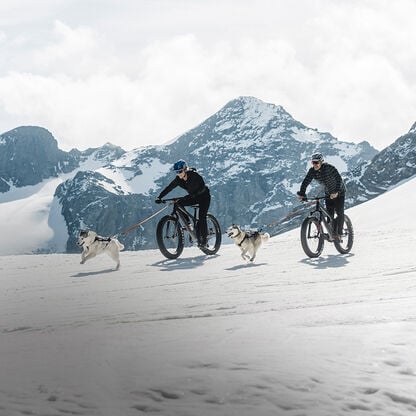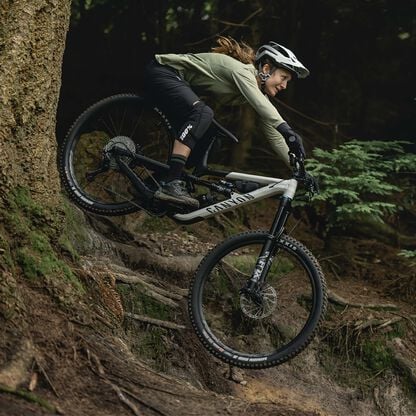Mullet vs. 29er: how to choose the right MTB setup for you
Mullet or 29? Which wheelsize combination is right for you?


Business in the front, party in the rear. This is the adage for the legendary 1980s haircut, the mullet. A combination of a short, sensible cut at the front, the business, combined with long hair at the back, the party, is one of the iconic looks of the era. Mountain bikers adopted this term as a kind of in-joke to refer to mixed wheelsize setups: a 29-inch front wheel, the business, and a 27.5-inch rear wheel, the party.
Today, the mountain bike market is dominated by 29-inch and mullet setups. They each have their pros and cons, and it can be confusing trying to peel away the jargon and hype to find the right setup for you. This short guide will walk you through why they became popular and what kind of rider would suit which kind of setup.
Contents
Why do people run mullet setups?
As the Great Mountain Bike Wheelsize Debate began to settle on 29-inch wheels, some riders started experimenting with smaller 27.5-inch wheels on the back. The benefits of a 29-inch wheel were undeniable; the big wheels make it easier to get up and over roots and rocks. Some riders, however, felt that these “29er” bikes were a little too hard to manage on tight, technical trails. By adding the smaller (27.5-inch) rear wheel, the theory was that you could get the best of both worlds - a front wheel that would roll over everything, combined with improved manoeuvrability at the back.
Mullet setups have become the number one choice for downhill racing today, with few riders still running a full 29-inch setup at the World Cup. On the other end of the spectrum, the chances of anyone even experimenting with a mullet for cross-country racing are slim. It is undeniable that if you need to cover ground as quickly as possible, 29-inch wheels are the way to go. This is why the entire cross country field uses 29ers today. Once you step between these extremes, however, the question of mullet or 29 becomes a much more nuanced topic and the answer of which will depend on what you are looking for as a rider.

Mullet vs 29er: Sender CFR Underdog vs Spectral CF 7
- Sender CFR Underdog - Canyon Sender CFR Underdog – World Cup speed and control, built tough for privateers.
- Spectral CF 7 - Trail balling on a budget. CF performance, accessible pricing and a solid spec. A lot to love, nothing to hate.
Mullet vs 29: Does my height make a difference to my choice?
For smaller riders, we think there is a strong argument for running a smaller rear wheel. With our Spectral trail bike range, which in most sizes can be switched between mullet and 29er, we decided that full 29-inch setups don’t make much sense for the smallest of riders. Having the larger rear wheel makes the bike harder to handle for them, so the XS is mullet-only.
There used to be an argument that taller riders would be better suited to a full 29er, but World Cup downhill racing has shown that this is no longer the case. Regardless of your height, the benefits of a smaller wheel on steep, technical terrain have been proven by our factory downhill team. This is why we have made the Sender downhill race bike mullet-only.
I prefer Mullet over 29. I think it is more fun and playful, and also works better on my DH bike. I think 29 is great for smaller travel bikes but on the bikes I enjoy to ride most, mullet works best!Luca Shaw

Mullet vs 29: Which is best for my trails?
When choosing between a bike with a mullet setup and a full 29-inch one, the big question is which wheel size would best suit you and where you ride. You need to ask yourself whether covering ground or bike handling is your main priority. Thinking about the kind of trails you ride is a great starting point.
Fast, rolling trails
Do your trails tend to be flatter with open corners? How important is climbing to you? If you usually ride on trails where carrying speed is more important than the ability to weave your bike through tight, technical sections, a 29-inch setup could be the right one for you. The bigger wheels will carry more speed and maintain it better through rough sections. The bigger wheels will also make the climbs that little bit easier.
Steep, technical trails
If you find yourself going down steep pitches and threading the bike through tight corners often, then a mullet might be a better option for you. On the steep sections, the smaller rear wheel allows you to get your weight back on the bike for confidence-inspiring descending. When you get to the corners, it will allow you to flick the bike through them with greater ease.
Mixed trails
If you are reading this and thinking, “My trails have both those things,” then the question is where do you find your fun? A full 29-inch bike is by no means difficult to ride on steep, technical sections, and will give you greater speed on the open sections. Flipping it around, a mullet will climb and hold speed really well, just not quite as well as the 29er, and can be a great recipe for more confidence when things get gnarly.
As a racer I have always preferred 29 for the rolling speed. As I transition out of racing I will experiment more with mullet to see if it's the more fun combinationJesse Melamed

Can I convert my bike to a different mullet or full-29?
In theory, any 29-inch bike can be converted to a mullet setup. With the larger 29-inch wheels, fitting a smaller rear wheel is not a problem. The drawback is that it will change the geometry, which may make the ride less enjoyable. The biggest issue with running a 27.5-inch wheel on a 29-inch bike is that it will lower the bottom bracket, which can mean your pedals will start hitting obstacles frequently. It also changes the riding position of the bike, tipping the weight backwards compared to the standard position. This will mean that the seattube angle becomes slacker, which could compromise climbing performance, and it will require your suspension to be re-adjusted to account for the new position.
Some mullet bikes may accept a 29-inch rear wheel, but it is very likely that there will not be clearance to fit the larger wheel in the rear triangle. If you are attempting this kind of conversion, we would recommend checking that there is space for both the wheel and tyre to fit your frame before you purchase a new rear wheel. If it can fit, you will find that the balance of the bike will have shifted forwards and the bottom bracket will be significantly higher, making the bike less stable at speed.
Geometry plays a huge role in how your bike feels and handles, especially when experimenting with setups like these. To understand how angles and measurements affect your ride, check out our mountain bike geometry guide.
I love the mullet. The bike is way more dynamic, much easier to control and place especially for me as I’m not very tall. I also have more space to move on my bike and I feel more comfortable.Marine Cabirou

The Spectral: No need to choose between 29-inch and mullet
If you are not sure whether you would prefer a mullet or a 29-inch setup, there is one foolproof answer to this question - the Spectral. Our award-winning trail bike is designed to accept both 29er and mullet setups with a simple flip-chip in the chainstay. If you purchase the full 29-inch version, you simply need a new rear wheel and an allen key to convert it to a mullet setup, and vice versa. The chip lengthens or shortens the chainstay to accept the wheelsize of your choice, while maintaining the rest of the geometry, so there is no compromise to make.

Spectral: Zwei Setups, ein Ziel – purer Spaß auf jedem Trail
- Spectral CF 7 Mullet: Agil, verspielt und bereit, von jeder Linie abzuspringen – das Mullet-Spectral bringt deine wilde Seite auf technischen Trails zum Vorschein.
- Spectral CF 7 29er: Schnell, souverän und auf Vortrieb ausgelegt – das 29er-Spectral rollt über alles hinweg, was sich ihm in den Weg stellt, gemacht für Fahrer, die nach Flow und Speed suchen.
What do Canyon crew members say?
Luca Shaw is the kind of rider who would have been pushed towards a full-29 setup in the past for World Cup downhill. Coming off one of his best-ever seasons in 2025 aboard the mullet-equipped Sender, he has no doubts. “I prefer Mullet over 29. I think it is more fun and playful, and also works better on my DH bike. I think 29 is great for smaller travel bikes but on the bikes I enjoy to ride most, mullet works best!” His teammate, Marine Cabirou, agrees, “I love the mullet. The bike is way more dynamic, much easier to control and place especially for me as I’m not very tall. I also have more space to move on my bike and I feel more comfortable. I like the mullet on all my bikes, trail bike, ebike, it means I can play even more on the trail.”
Even though he is a shorter rider, former Enduro World Series champion Jesse Melamed is 29 all the way, “As a racer I have always preferred 29 for the rolling speed. As I transition out of racing I will experiment more with mullet to see if it's the more fun combination.”
Our CLLCVT trail bike shredder, Braydon Bringhurst, agrees:
Definitely mullet. It is more dynamic and it's just better for descending the bike. Climbing, it's not a big enough difference to compensate for the descending experience with the mullet.Braydon Bringhurst

Deciding between a mullet and a 29er?
If you are struggling to decide which wheelsize combination would suit you better, we think there is one simple exercise that can help:
- Write down ten rides that you would like to do in the next year.
- For each ride, think about what you find most fun on that ride and whether it would best suit a 29er or a mullet setup.
At the end of the day, there is no right or wrong answer; all that matters is what you find fun. And if you are still struggling to choose, remember that with the Spectral, you’re not locked into a single wheelsize because the bike can accept both.
Need some help deciding which Canyon mountain bike is right for you? We have a full set of buying guides to help every type of rider find a great bike. Maybe you are new to the sport and it all sounds very confusing? Our beginners’ guide to MTB will walk you through what you need to know to get started and hit the trails with confidence.
If you have never ridden different wheelsize combinations, there is no substitute for riding them. The friendly, helpful teams at our Canyon Experience centres will be happy to talk you through the bikes and can help arrange test rides for you. If you feel like you are getting lost worrying about wheelsize, then it might be worth using our Model Finder tool to walk you through the questions to finding your perfect bike. Our Bike Comparison tool can help you compare individual models head-to-head.
Whichever wheelsize you prefer, we know you’ll have a great time aboard whatever Canyon bike you choose. The only thing that really matters with mountain biking is how much fun you are having. See you out on the trails.
Discover our Mountain Bikes
Did this article help?
Thank you for your feedback
-
 About the author
About the authorMatt Wragg
Get to know Matt Wragg, the freelance photographer, writer, and self-proclaimed bicycle-breaker based in Nice, France. Despite unsuccessful attempts at XC, trials, 4X, and DH racing, Matt's passion for mountain biking never waned. After a stint in communications consulting, he decided to pursue his love for cycling and moved to New Zealand. Since then, he has traveled the world, chasing trails and building a successful career as a cycling photographer and writer. In 2021, he was diagnosed as autistic and has been coming to terms with it. His bike cellar is a true testament to his love for cycling, housing bikes that range from freeride to cargo.




